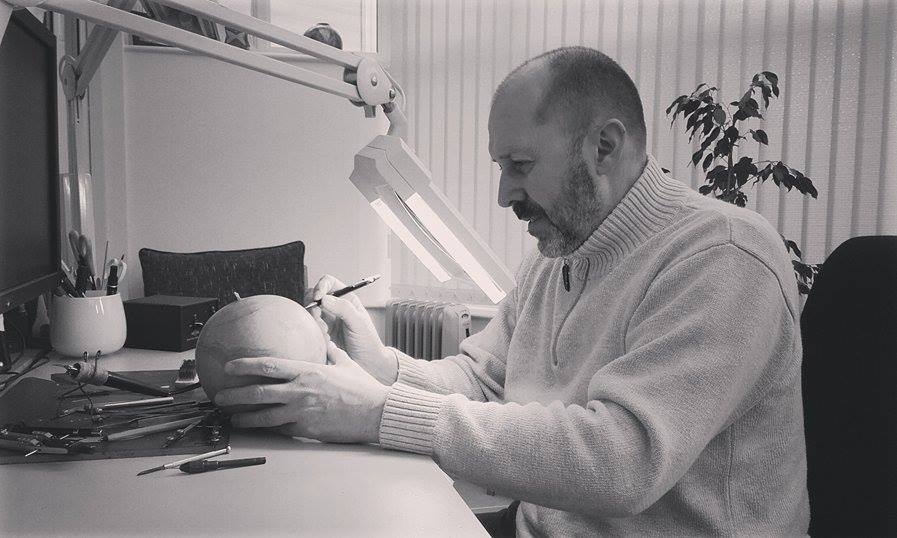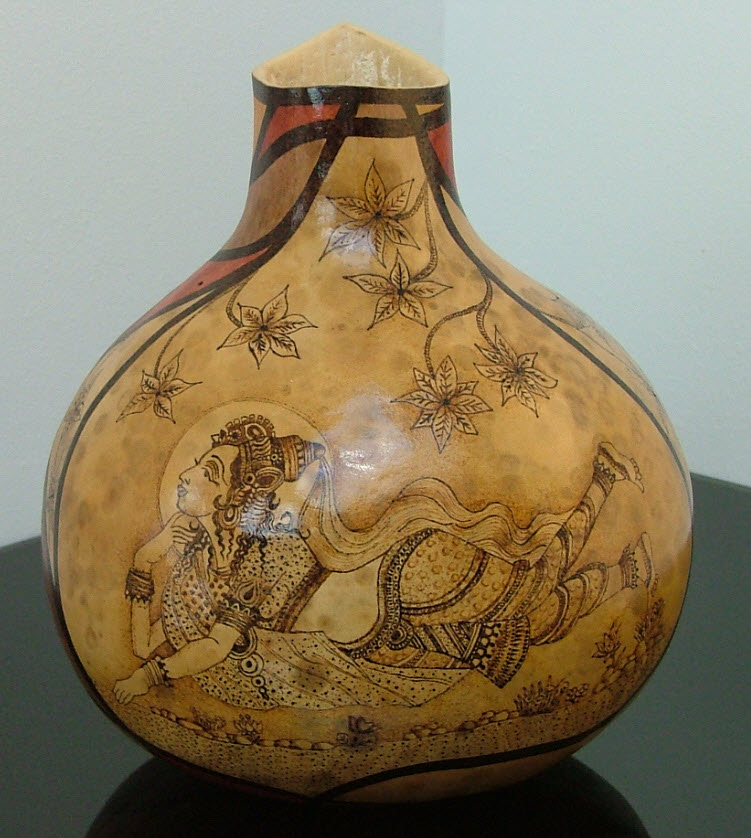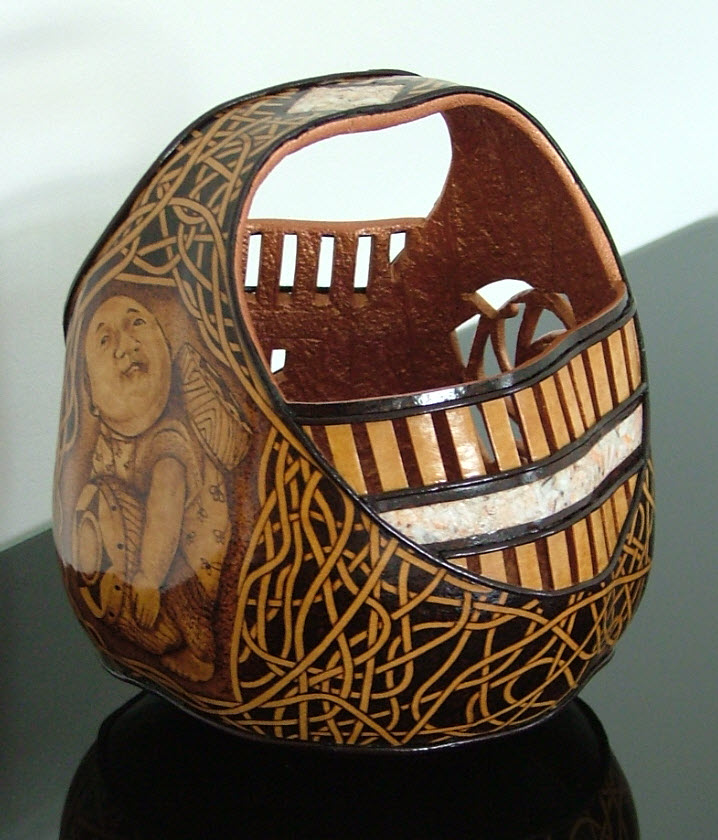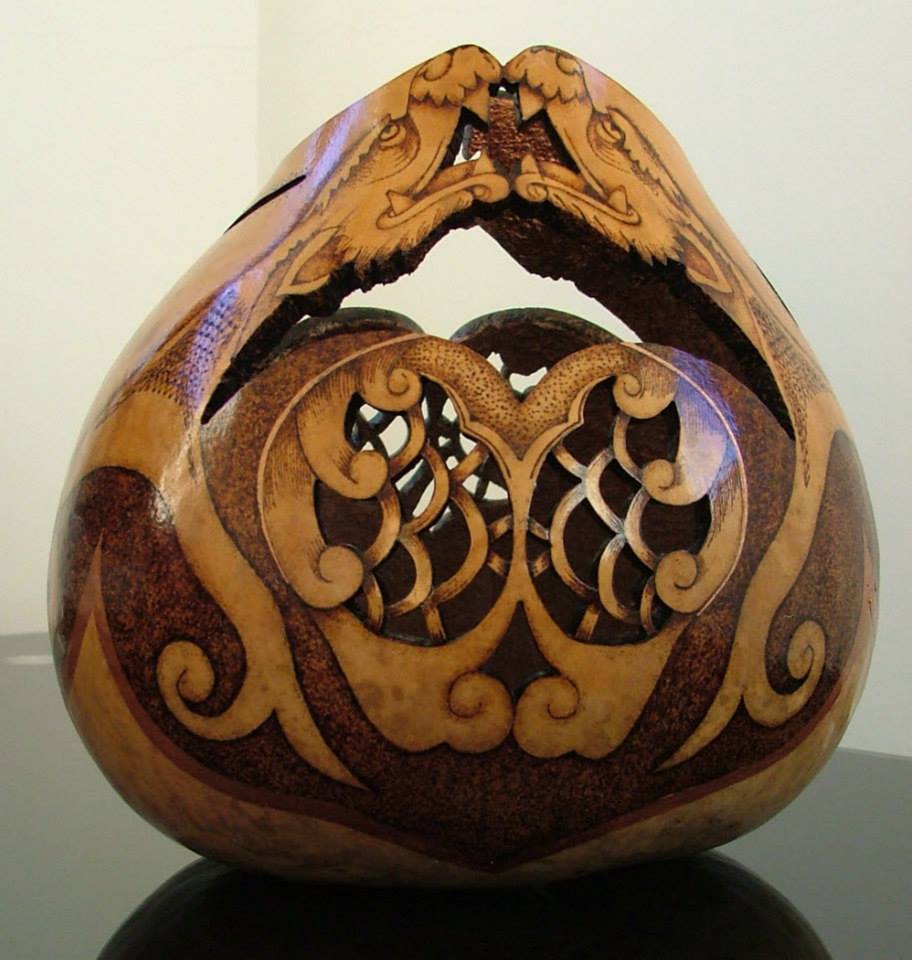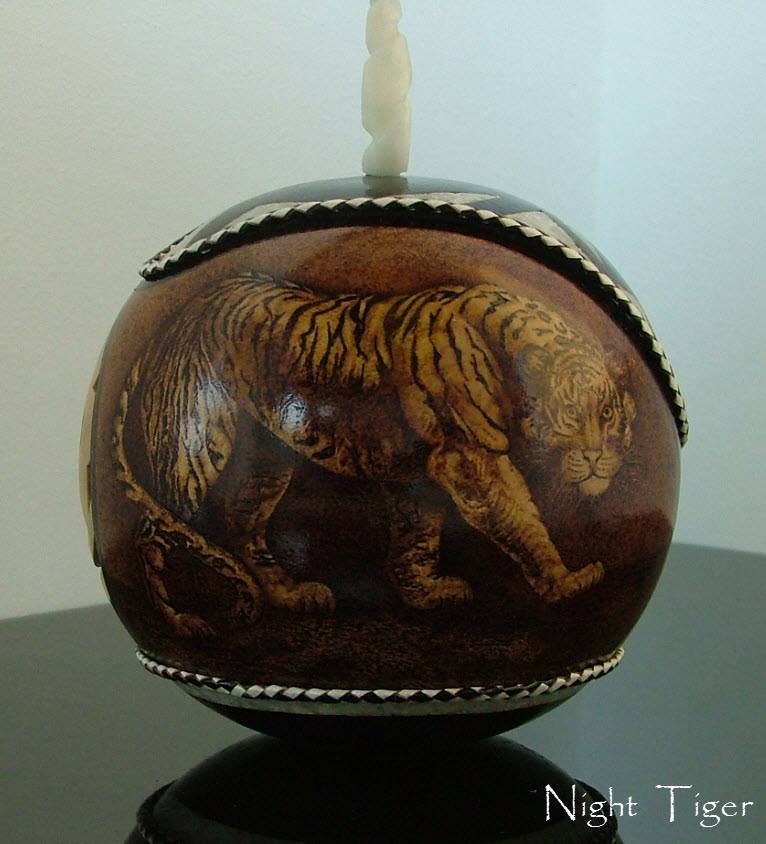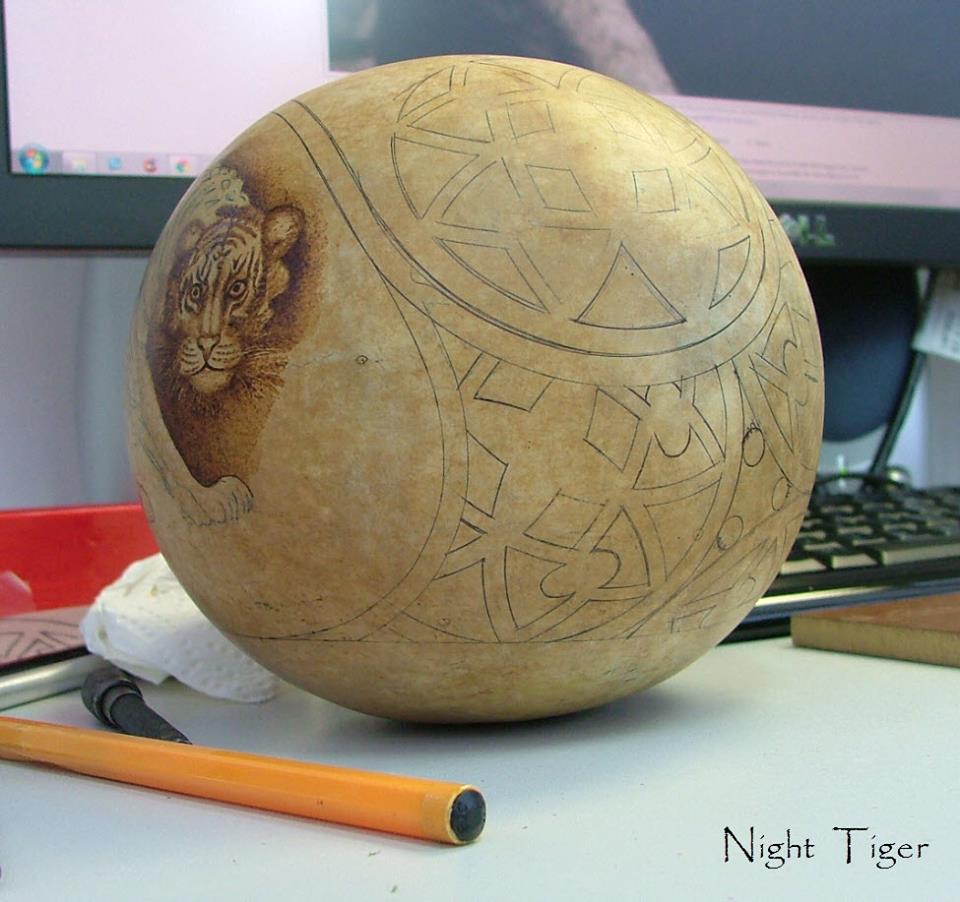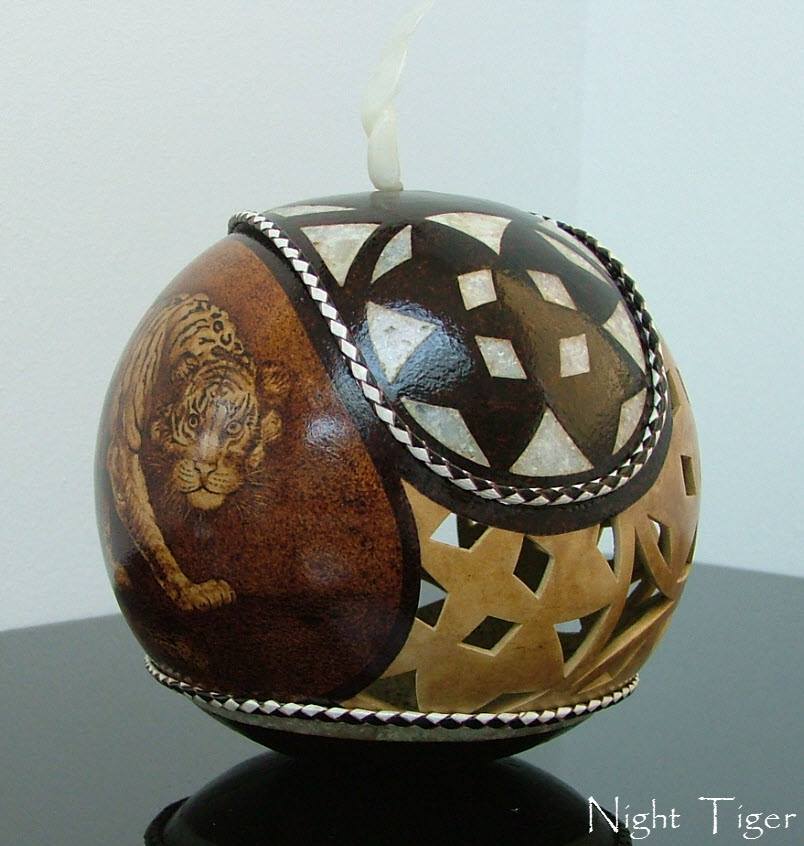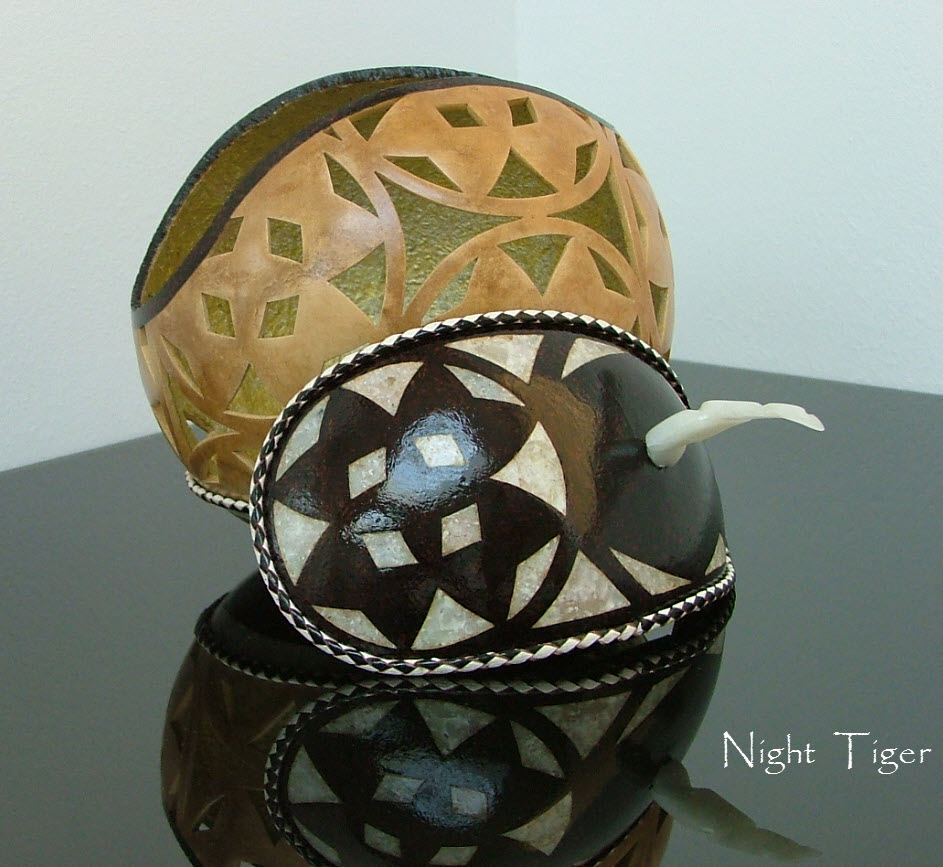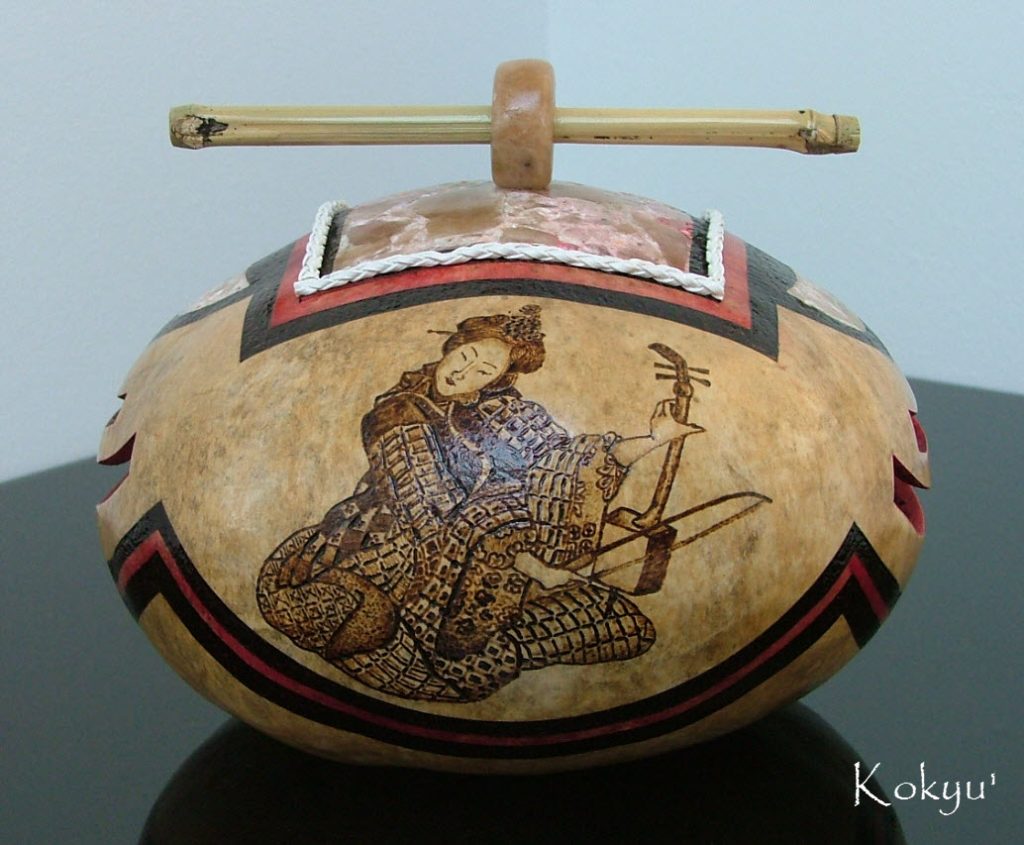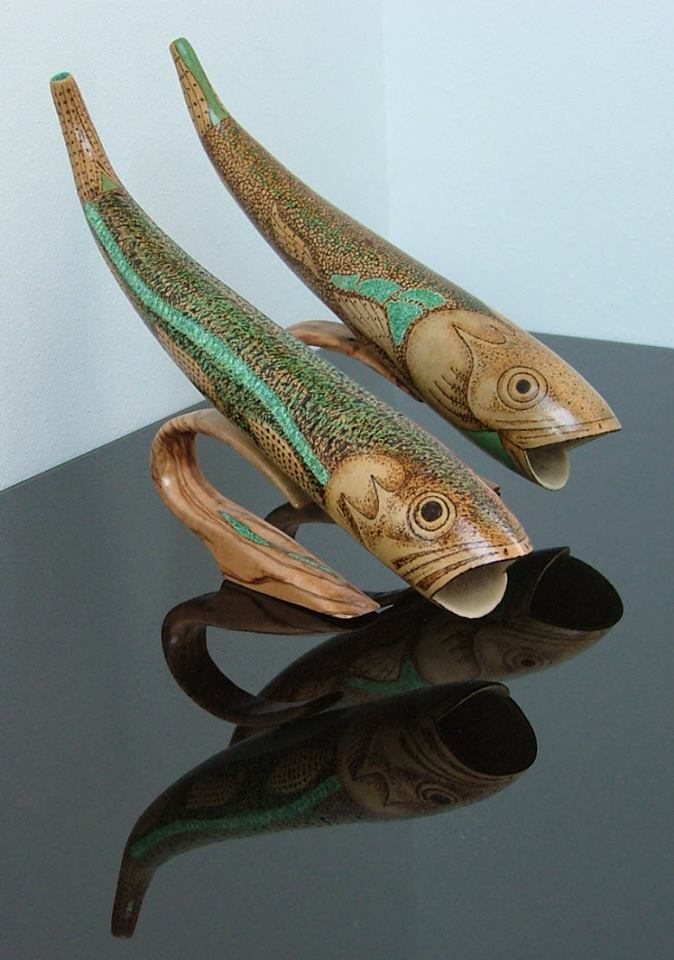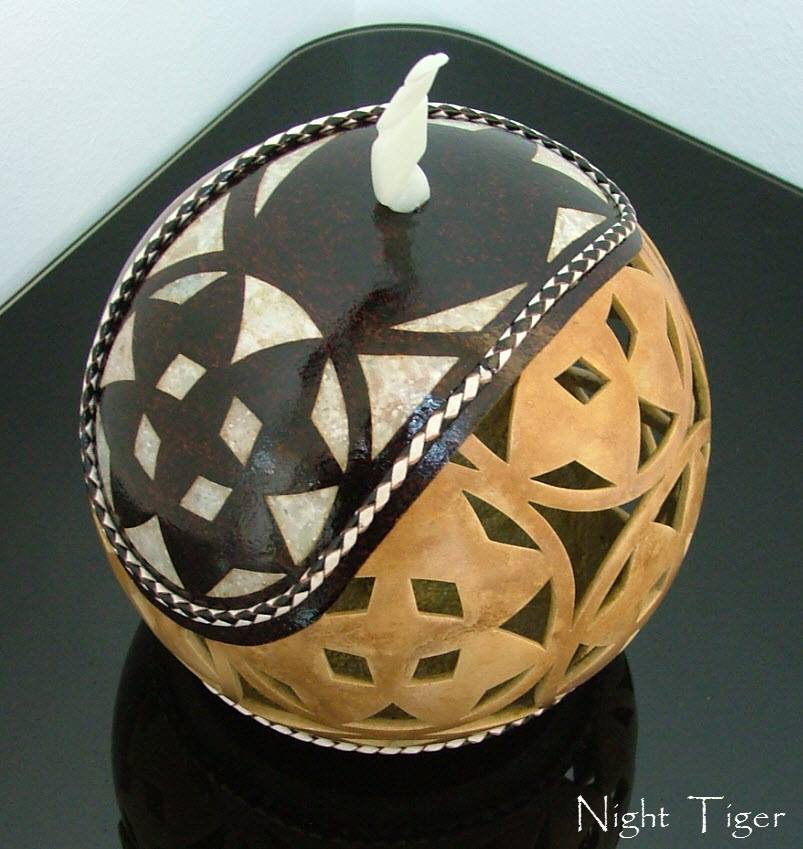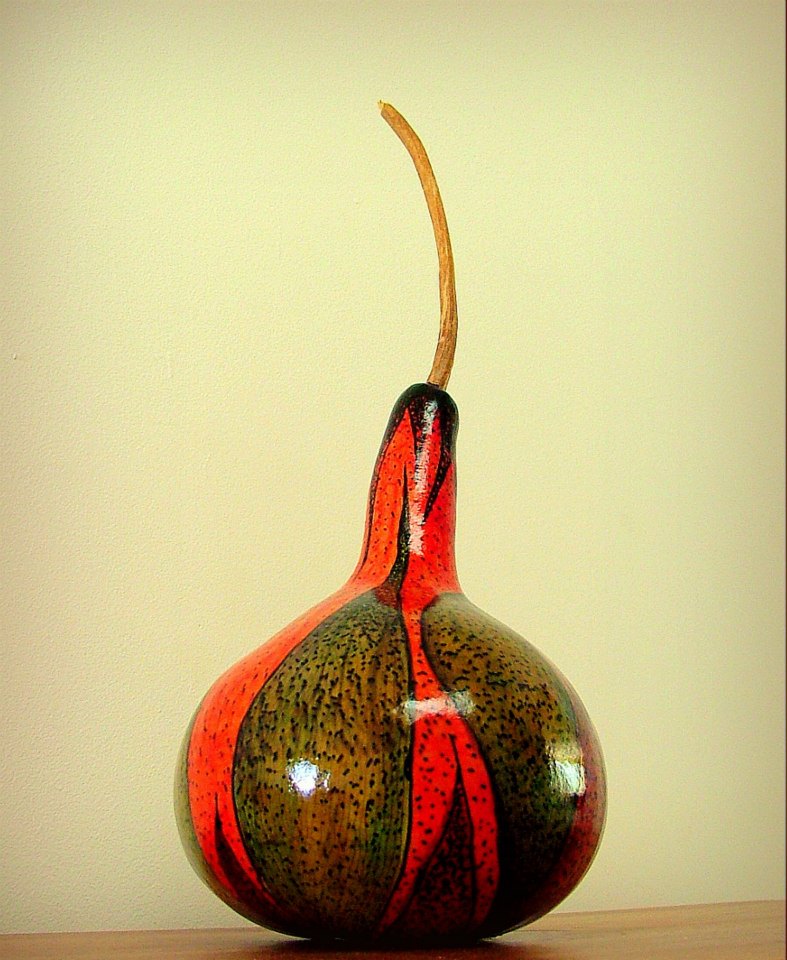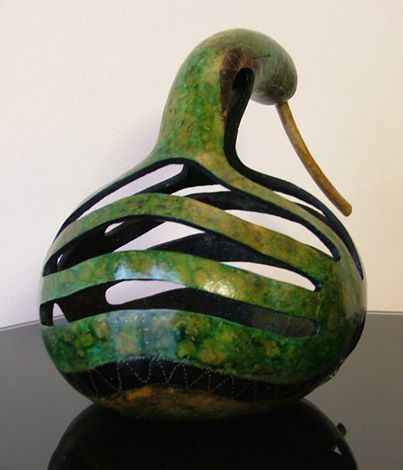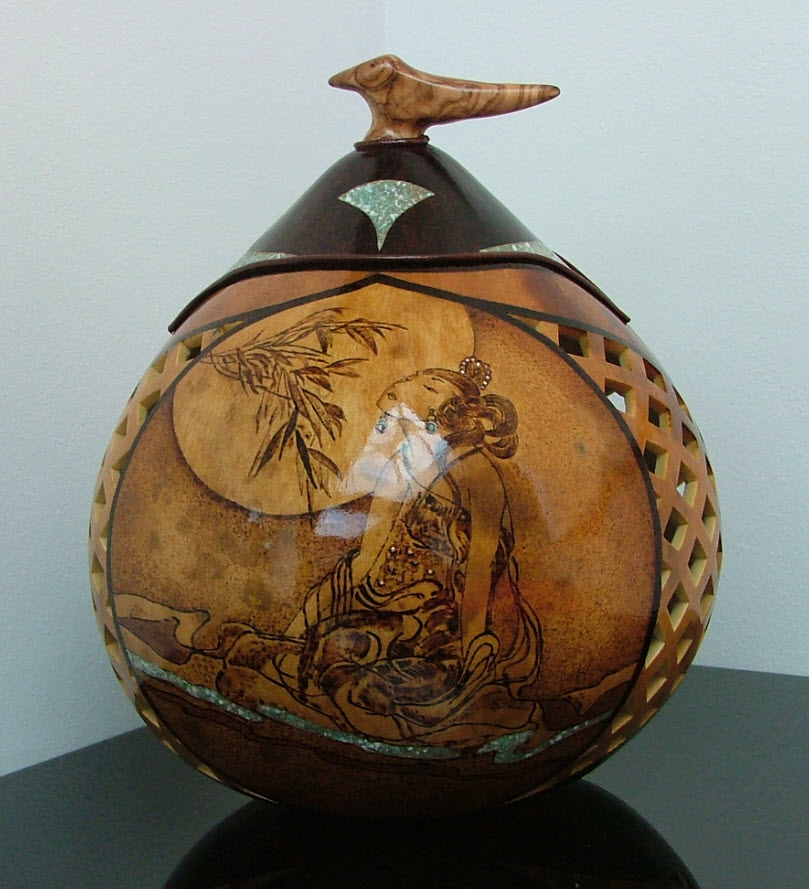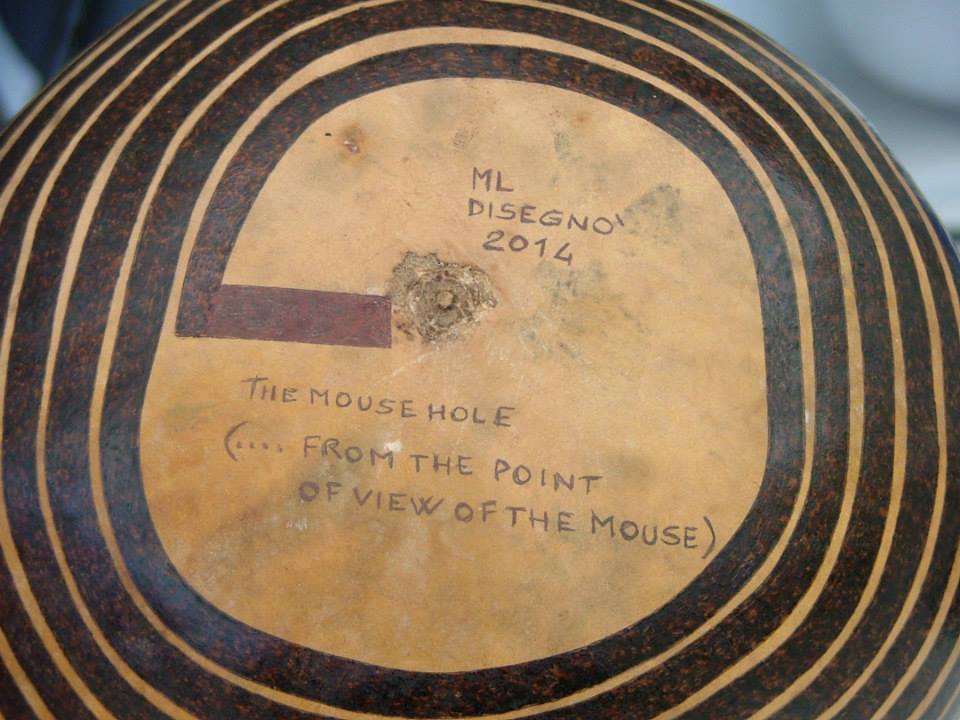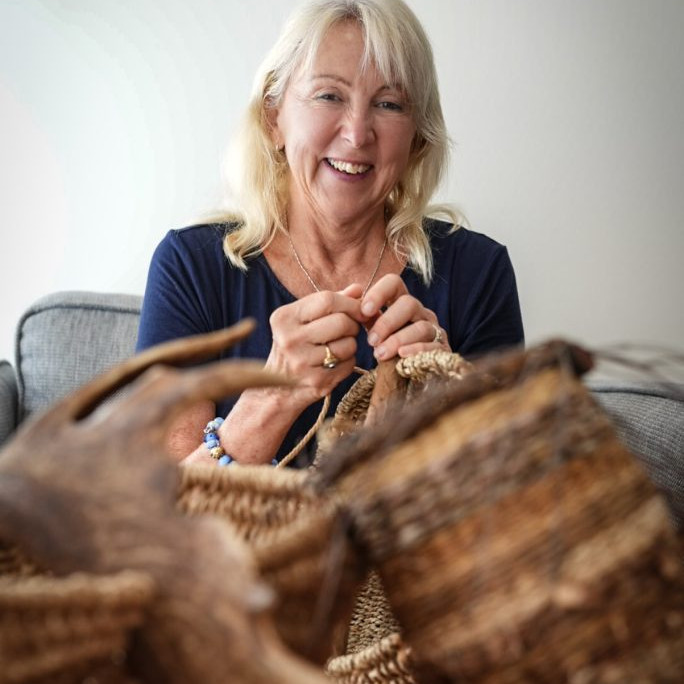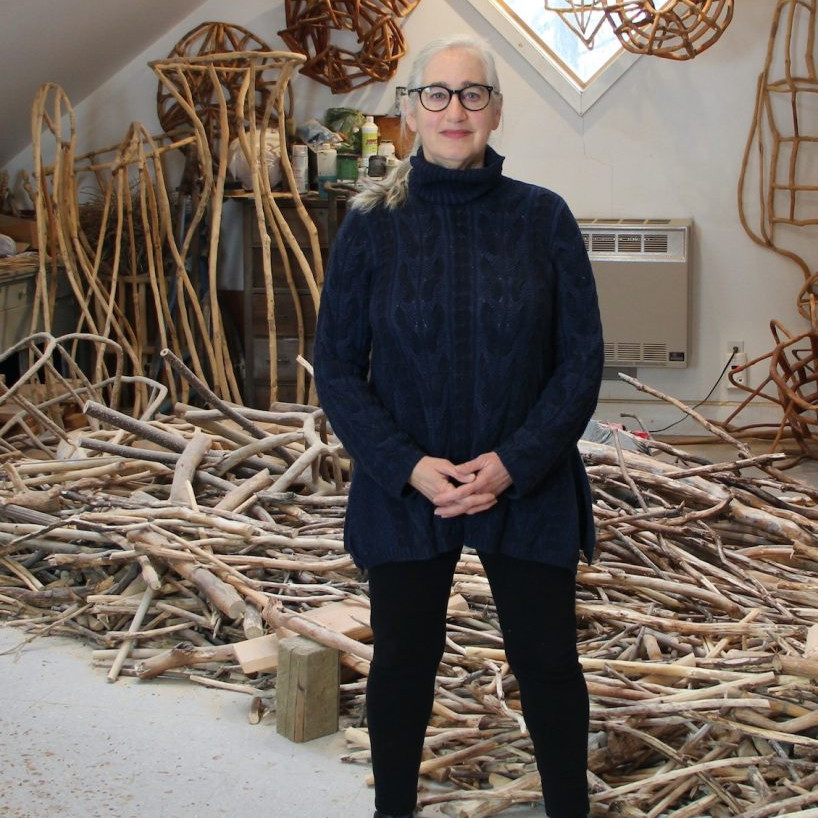Massimo Leotardi Eco Atist - Cheshire, UK
Before I ask you questions about your art work can I ask about gourds?
Where did they come from originally?
Gourds are hard-shelled plants, belonging to the squash and pumpkin family. They originate in Africa and South America, where they have been used throughout history as vessels for keeping and transporting water and food and also to make a variety of musical instruments.
Lady of the Lake
Where do you source your gourds from?
Originally I sourced gourds from a farm in Italy, but now my gourd supply comes from an American farm: Amish Gourds, York Pennsylvania, USA.
How do they vary, colour, size, and shape?
There are about six or seven shapes of gourd, which develop naturally as they grow on the vine: bottle shape, banana shape, cannonball, canteen, snake-shape, copper canteen-shape, martin (kettle) shape. The colour of the gourd is dictated by the way the farmers dries them – they are usually dried over six to eight months and when they dry if they are in a hot and dry environment they develop a light honey colour. The drier and hotter it is, the more uniform the honey-colour is, with fewer spots and stains. Ideally, the gourd, which is full of moisture when first picked, should be hung so that all the moisture seeps out with the heat, leaving inside a dry mass. If the gourd is not dried well, it becomes a darker, browner colour. Gourd dimensions range from the size of an egg to 60 cm in diameter.
Explain a little about the history of gourds as an artistic material?
The hard shell of the gourd lends itself perfectly to be either decorated or carved artistically. Archaeologists have found examples of finely carved and decorated 3,000 year old gourds in Peru which were used as soup and drinking bowls. Nowadays gourd art is very popular in North America where gourds are decorated traditionally for their holiday season (covering Halloween, Thanksgiving and Christmas).
When and how did you first start to work with gourds?
I was first inspired to try gourd art after seeing a highly decorated African gourd at the home of my parents’ friends in Italy. It was a big, round gourd decorated with wood burning and ever since I wanted to try my hand at applying my own style to a gourd. I first got the chance to try about seven years ago when I bought some gourds from Italy and I started decorating them with ink and experimenting with wood burning on them. I wanted to achieve a completely original way of decorating them, so over time I developed different techniques.
What is the technique you use?
The techniques I use are linked to my artistic background – my previous job was as an engraver for watermarked banknote paper. My home town in Italy is Fabriano “la citta’ della carta” (the city of paper) where watermark techniques developed in the 12th century.
I applied my technique for chiaroscuro drawing to the wood burner and also the carving and cutting techniques I used before on the watermark mould process transferred fairly easily to carving on the gourd.
The techniques I use now are: wood-burning, carving cut-out and inlay with different materials such as soapstone, crushed seashells or ground copper.
The cut-out is important to create shadows and silhouettes with the light, which make the environment surrounding the gourd more interesting.
Kiss of the Dragon
I like experimenting with new materials that I have not seen used before on gourds, such as leather and rope trim.
For the colour I use acrylic and alcohol-based ink.
As the gourd is a natural product with an irregular shape and surface, you have to be very careful and compensate for the irregularity by making the design appear regular on the surface.
Discuss this using the 9 images from Night Tiger to explain.
In Night Tiger the main feature is a wood-burnt tiger inspired by ancient Indian art. The burner is electric with an incandescent wire which burns the wood, giving a sepia effect on the surface of the gourd. I first drew the image of the tiger on paper and then copied it with a pencil onto the gourd. When I was happy with the pencil image on the gourd, I went over it with a ballpoint pen, before burning the image on with the wood burner.
Night Tiger also has a cut-out design, which in this case is a repetition of the same pattern – to create this I drew the pattern first on plain paper, then transferred this to tracing paper. I then put the tracing paper onto the gourd and rub it, so the image transfers to the gourd (this is another technique I learned in wax engraving for watermarked paper). I then carve out the pattern using a miniature saw blade.
I then did the cut-out design for the inlay and fill it with crushed soapstone. I then sanded this down until it was smooth.
The handle of the lid is also made of carved soapstone to resemble a tiger’s claw. Soapstone is a soft stone which is fairly easy to work with using files.
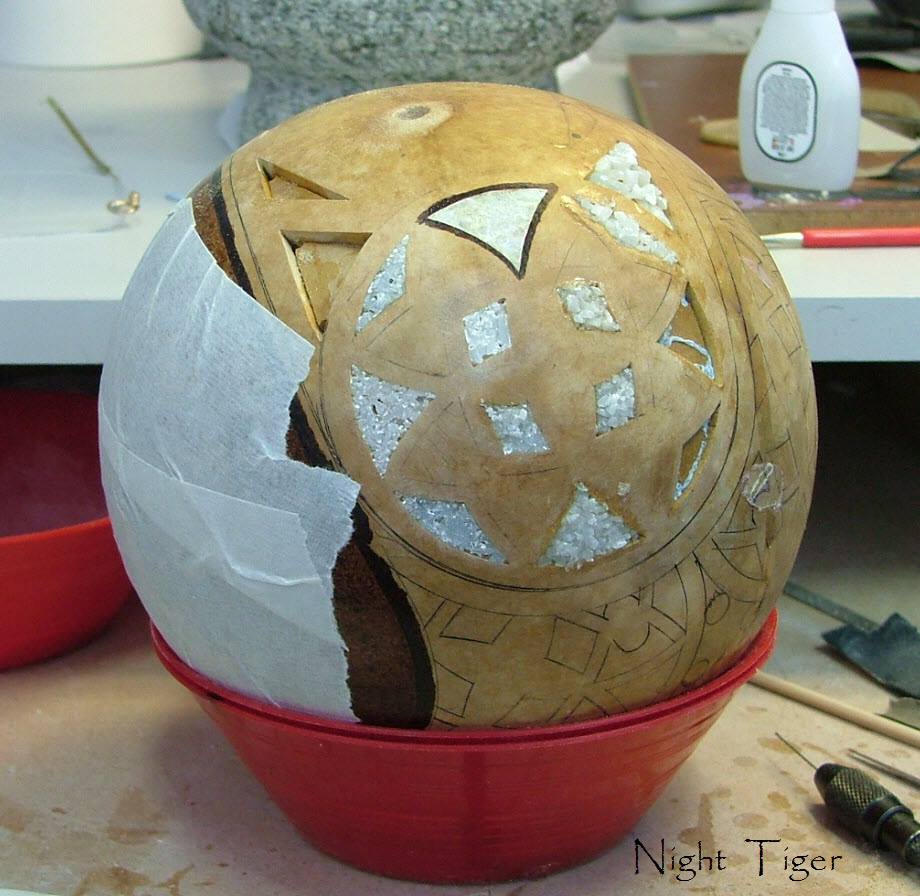 The inside of the dried gourd of Night Tiger was painted in gold acrylic.To finish, I applied a black and white leather trim to the gourd.
The inside of the dried gourd of Night Tiger was painted in gold acrylic.To finish, I applied a black and white leather trim to the gourd.
For a finishing touch, as for all my gourds, I applied a clear varnish (by spray) to the gourd.
What are your personal thoughts on using other cultures as your base, e.g. Asian and even Spanish?
I have always been fascinated by Asian and oriental art and culture and before creating works I do a lot of research into ancients techniques such as Netzuke – this is an ancient Japanese carving technique which was used by Samurai on ivory ornaments to go on their belts.
Discuss your work Pesciolini in Verdigris?
As mentioned before, I always like to experiment with new material. Verdigris, which is the patina which forms on copper over time (which you often see on church domes). This is a very difficult material to use because it is very light in weight, but it gives a very vibrant green colour on the work. To create the pescolini (little fish) I chose 2 banana-shaped gourds whose form lent itself to the fish image.
Take two different lids and their tops and discuss shapes in relationship to the base and design?
On ‘Night Tiger’ and ‘The Right Way to Look at Life’ I studied the natural curvature of the gourd and cut the lid using by first making an incision with the blade and then I insert my miniature saw blade and follow it all around. The shape of the lid follows the natural flow of the gourd’s surface – as the gourd is a natural product I avoid using straight geometrical lines on the lid.
‘Night Tiger’ 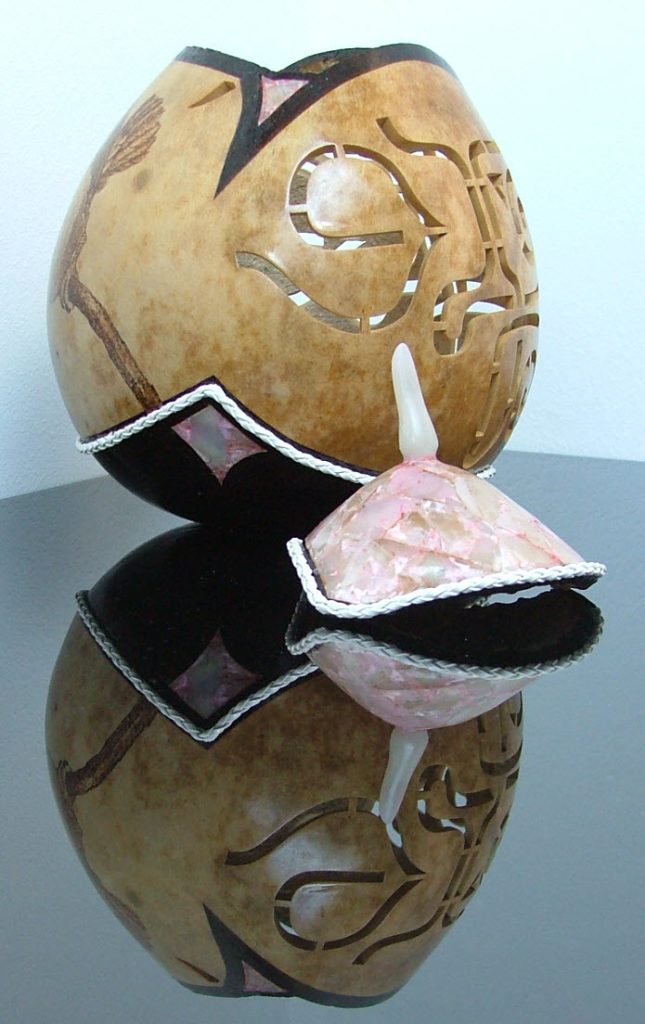 ‘The Right Way to Look at Life’
‘The Right Way to Look at Life’
Expand on how you introduce colour to your work?
I apply colour sparingly to the gourd because I don’t want to invade the natural appearance of the gourd itself – the colour enhances the gourd, rather than dominating it – I don’t want the gourd to just appear like a mechanically-produced vase.
As mentioned above, I use acrylic paint and alcohol-based ink; verdis gris, and naturally coloured soapstone (green, white, reddish-brown).
Discuss the green coloured gourd worked to look like a bird?
This piece is one of my early works, when I was first experimenting with different techniques – the natural shape of the gourd brings to mind a swan with a long neck. (More than anything, this was an exercise when I was defining my style.
How often does the original shape of a gourd present the foundation for a piece?
I like to follow the natural lines and flow which Nature has created within the gourd to complement what Nature has already put there – I see my work as the enhancement of a beautiful natural form. I don’t want to clash with the natural state of the product by making straight lines on it, or making it appear to artificial – I think this would diminish the beauty of the natural object.
The gourd shape guides me in the design and inspires me while I am progressing with the work.
Kissing the Moon
Explain how you sign your work?
I sign my work “M L disegno’” which means “ML drew this” – again this is a throwback to my watermark banknote experience: in old times there was a designer and an engraver for old Italian banknotes, so it was always written on the banknote “So-and-so drew this” for the person who designed it, and also “So-and-so engraved this” which was for the intaglio engraving.
What is both the strength and life expectance of your work?
The gourd itself is fairly robust, and as long as it is treated carefully and not dropped, it should last indefinitely.
Contact details.
Email: massimo.leotardi@gmail.com
Website: www.leotardidesigns.co.uk
Massimo Leotardi, Cheshire, UK
Interview by Deborah Blakeley, April, 2016
Think a colleague or friend could benefit from this interview?
Knowledge is one of the biggest assets in any business. So why not forward this on to your friends and colleagues so they too can start taking advantage of the insightful information the artist has given?
Other artists you may be interested in:


